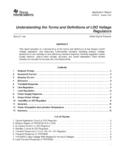Transcription of Factors Affecting Credit Risk in Personal Lending
1 This PDF is a selection from an out-of-print volume from the NationalBureau of Economic ResearchVolume Title: Commercial Banks and Consumer Instalment CreditVolume Author/Editor: John M. Chapman and associatesVolume Publisher: NBERV olume ISBN: 0-870-14462-6 Volume URL: Date: 1940 Chapter Title: Factors Affecting Credit Risk in Personal LendingChapter Author: John M. ChapmanChapter URL: pages in book: (p. 109 - 139)5 FactorsAffecting Credit Risk inPersonal LendingTHE Credit standing of an applicant for a Personal loan isinvestigated intensively because it indicates, within reason-able limits, the likelihood of repayment. It should not beassumed, however, that a bank officer can foretell with cer-tainty how faithfully a borrower will meet his obligations;few applicants have economic prospects so bad that there isnot some small chance of repayment, and few are so well sit-uated that there is not some possibility of delinquency oreven default.
2 The selection of borrowers must therefore reston probabilities. On the basis of experience, and to some ex-tent intuition, the loan officer decides which applicants aremore likely to default than others or which loans are likelyto involve collection costs so great as to render the and ability of the borrower to repay the loanare the primary Factors to be considered in any appraisal ofcredit risks . Applicants who may be attempting fraud areclearly undesirable, as are those who, though not strictly dis-honest, may appear to be irresponsible. The second criterion,ability to repay, may be tested by several standards: by per-sonal characteristics such as age, sex and family status; andby the borrower's occupational or economic position, incomeand net general, then, the bank is interested in the moral, per-sonal, vocational and financial characteristics of the applicantfor a Personal loan. The would-be borrower is asked to109110 BANKS AND INSTALMENT Credit supply Credit references, banking connections and informa-tion concerning his charge accounts, since these give someevidence of his probity.
3 Age, sex, marital status, number ofdependents and permanence of residence, are pertinent per-sonal characteristics. The nature of the applicant's occupation,his tenure of employment, and the industry in which he is en-gaged are clues to his ability to pay. His income, assets (realestate,, household goods, automobiles, stocks and bonds) anddebts (mortgages, charge accounts and instalment accounts)serve to indicate his financial capacity. These characteristicsare all, of course, interrelated. Personal traits affect, and arein turn affected by, an applicant's occupation and earningpower. A balanced income-expenditure relationship, or asubstantial net worth, reflects not oniy the borrower's finan-cial capacity but also his prudence and f resight in the man-agement of his following pages are devoted to a statistical analysis ofthe principal Factors Affecting Credit risk. The informationon which the study is based was obtained from a sample of2,765 applications of persons to whom loans were data, secured through the cooperation of 21 large banksoperating Personal loan departments in 16 cities situated inii states,1 are presented in a series of tables giving the distri-butions of good and of bad loans according to the several riskfactors selected.
4 The information covering this group of bor-rowers pertains only to their financial, Personal and voca-tional characteristics. No direct information was requestedon past payment record, legal actions or the quality of refer-ences given, and consequently the analysis provides no ade-The cooperating banks were asked to provide random samples of good andbad loans. Good loans were defined as those which paid out without anyspecial collection difficulty and bad loans as those which either were excessivelydelinquent or ended in de(ault. The drawing of the samples was subject toonly two conditions: (1) that the loans in both samples were made within thesame period of time; and (2) that their distributions over that period werenearly identical. Although there is no certainty that the drawing was trulyrandom we have based our conclusions on such an Affecting Credit RISKIII quate treatment of what we have called moral may be inferred from the data only insofar as they aresuggested by such related Factors as stability of employmentand of residence, and character of IN THE ANALYSIS OF BAD-LOANEXPERIENCEOur sample consists of records of actual borrowers, some ofwhom repaid their Personal loans substantially as scheduledand some of whom did not.)
5 Since these borrowers had al-ready passed through a selection process at the hands ofcredit men, the sample cannot be considered completely rep-resentative of the general run of Personal loan results may suffice to show whether or not Credit menshould have been more selective than they were, but they donot indicate whether they should have been less is no way of measuring what proportion of rejectedapplications would have proved satisfactory if accepted, andit is therefore impossible to eliminate the bias attributableto the prior selection of nature of this bias is illustrated in Table 26 whichsummarizes the reasons for the rejection of 1,713 personalloan applicants by a metropolitan bank. The first two rea-sons too much borrowing and weak statement account forabout 50 percent of the total number of rejections and suggestthat the vocational and financial characteristics of theseprospective borrowers were unsatisfactory. Rejections ofthis nature might well be expected to bias the sample.
6 Onthe other hand, rejections for "failure to mention existingloans with other members," a reason which presumably indi-cates dishonesty or irresponsibility, may not bias the sampleappreciably; and the same may be true of the last four itemsin the table. The reason "poor previous Credit record with usor others" may indicate dishonesty or irresponsibility, in112 BANKS AND INSTALMENT CREDITTABLE 26 Percentage Distribution of 1,713 Personal LoanApplications Rejected by a Metropolitan Bank, byReason for RejectionREASON FOR REJECTIONPERCENTToo much statement43. 9aPoorprevious record with us or to mention existing loans with other members21 .8 Comaker in open legal account with others1 .5 Borrower in open legal account with others1 .5 Judgment record with our consists chiefly of applications showing insufficient income, un-stable employment, unsatisfactory comakers and the case these rejections probably are not a source of , however, rejection attributed to this cause results fromfinancial weakness, it thight well bias the study of Credit experience is necessarily based on cer-tain arbitrary assumptions.
7 In the first place we have assumedthat all loans can be divided into two mutually exclusiveclasses, one consisting of good loans with which the bank hadno special collection difficulty, and one of bad loans whichgave rise to one or more of the following collection prob-lems: the bank collected from a comaker; the bank took legalaction;the loan was excessivelydelinquent;2 the bankcharged off the In the second place we have assumed2delinquency" was defined as 90 days or of these standardized criteria for characterizing a loan as good orbad, there were inevitably certain borderline cases that could be cataloguedas bad loans only arbitrarily. Moreover, there was considerable variationamong the samples as to the relative significance of the different types ofbad loans. Thus, although legal action or collection from a comaker occurredin 37 percent of the bad-loan cases reported by all banks combined, suchtreatment was reported by one bank for 96 percent of its cases, and by twoothers for only 6 percent.
8 See Table Affecting Credit RISK113that each of our supposedly mutually exclusive classes hassome distinguishing characteristics, even though in otherrespects the two samples may be is scarcely to be expected that banks operating in dif-ferent regions, serving different classes of customers and fol-lowing different policies, would have uniform , for each of the Factors to be analyzed, we havesupplemented the composite analysis for all banks by an in-dividual analysis for each bank that submitted a sufficientlylarge sample. These individual analyses, which are presentedin Appendix B, indicate the degree of variation among banksand the extent to which the average experience of all bankstypifies theexperience of any one bank. It will be seen thatin some instances the individual samples differ widely fromone another, and thus from the average of the compositesample, and that in others the composite findings are validalso for most of the separate tables used in the main body of the following discus-sion are based on the entire sample, comprising 1,468 goodloans and 1,297 bad loans.
9 But in these summary tabulations,which represent a combination of the samples of all banks,the separate distributions of good and of bad loans for eachbank have been so weighted that the combined sample maybe considered to comprise 1,294 good loans and the samenumber of bad The banks cooperating in this surveywere asked to submit approximately equal-sized samples ofthe two types of loans, because an equal division is most effi-ciently studied. A group of only two hundred cases, for ex-ample, would be large enough to be of some interest if itwere divided equally; but if the group contained only two orthree bad loans out of two hundred a proportion whichmight result from a random drawing from all the loans in abank's portfolio it would be useless for our present pur-4 Formethod of weighting see Appendix B, p. AND INSTALMENT Even though our good-loan sample accounts for a farsmaller proportion of all good loans than the bad-loan sampledoes of all bad loans, a sample of one hundred good loans isjust as representative of an indefinitely large universe of goodloans as a sample of one hundred bad loans is of an indefi-nitely large universe of bad loans.
10 This is true be ause thesampling error, which measures the extent to which a samplemay be considered representative of the larger universe, de-pends on the absolute number of cases in the sample, and noton its proportion to the computation of sampling error is an important partof this analysis. If a sample of good loans shows characteris-tics different from those of a sample of bad loans, it is alwayspossible that the difference is merely a matter of chance; andthe smaller the sample the greater is this possibility. Severaltests of statistical significance have been devised to determinethe limits of probable sampling error. In the present studywe applied the Chi-square test,6 using the 1 percent standardof statistical significance. Accordingly, when we found adifference in the distributions of good-loan and bad-loansamples we did not accept this difference as evidence of agenuine characteristic of the whole body of loans from whichthe sample was drawn unless we could show that there wasno more than one chance in a hundred that a difference sub-stantially as large would be found in a random sample froma universe which actually had no such characteristic.















